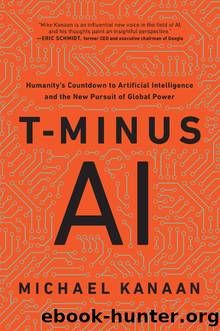T-Minus AI by Michael Kanaan

Author:Michael Kanaan
Language: eng
Format: epub
ISBN: 9781950665136
Publisher: BenBella Books, Inc.
Published: 2020-06-19T00:00:00+00:00
FROM ROBOTS TO BOTS
I believe that robots should only have faces if they truly need them.
—Donald Norman
Director, The Design Lab at the University of California, San Diego
Everyone stops to watch a robot. Whether it’s a small, round Roomba vacuuming its way across our kitchen floor or a YouTube clip of a two-legged, mechanical humanoid doing a backflip before bounding up a flight of stairs, it’s tough to take our eyes away. That’s especially true if the robot not only looks and moves like us, but also speaks like us. Marketing agencies know how strong the allure of these mechanical creatures is, and it’s therefore no coincidence that robots have become a common theme behind many advertising strategies. Just think of all the major corporations and manufacturers suddenly using robots as product spokespersons in their television and other advertising campaigns. It’s pretty clear that if you show people a robot, they’ll look . . . although they might focus more on the mechanical character than the message.
But what exactly defines a robot as something more than just a machine? Is it only semantics, or is there some threshold a machine must cross before we consider it worthy of the loftier name robot? With today’s ever-evolving mechanical and computer engineering capabilities, the answers have become a bit unclear and confused, especially because the words machine, robot, and bot are often used ambiguously. Even hardware and software engineers within the robotics industry itself often employ the terms interchangeably and inconsistently. Despite the confusion, it’s important to understand the differences between machines, robots, and bots—especially because of the different ways artificial intelligence and machine learning applications can be utilized in each.
Most simply stated, a machine is any device with mechanical or electrical parts that engage or interact internally to accomplish a task or perform a function. From simple to complex, machines can be constructed so their parts execute consistent, repetitive movements, or they can be designed and even digitally programmed so their parts are capable of operating or moving differently under different circumstances, or depending on the operator’s needs and preferences. Either way, machines always require some kind of power or infusion of energy to activate their component parts. That power can come from a variety of different sources. People often provide the energy behind the most basic machines, but combustion, steam, electricity, magnetics, pneumatics, nuclear energy, and, in the developing field of nanotechnology, even molecular motions are now used as power sources. As the world looks to become more green, natural forces like wind, water, and the sun are gaining popularity. Regardless, machines can be as fundamental as a pulley on a string or as complex as a supercomputer or space station in orbit.1
Robots incorporate the fundamental aspects of machines, but they also include additional mechanical or digital capabilities that distinguish them as something definitively more. Though widely diverse within their own ranks, all robots have components that allow them to obtain information from their environment, process the information they’ve obtained, and adjust
Download
This site does not store any files on its server. We only index and link to content provided by other sites. Please contact the content providers to delete copyright contents if any and email us, we'll remove relevant links or contents immediately.
Algorithms of the Intelligent Web by Haralambos Marmanis;Dmitry Babenko(8523)
Test-Driven Development with Java by Alan Mellor(7431)
Data Augmentation with Python by Duc Haba(7322)
Principles of Data Fabric by Sonia Mezzetta(7070)
Learn Blender Simulations the Right Way by Stephen Pearson(7009)
Microservices with Spring Boot 3 and Spring Cloud by Magnus Larsson(6827)
RPA Solution Architect's Handbook by Sachin Sahgal(6240)
Hadoop in Practice by Alex Holmes(6033)
The Infinite Retina by Robert Scoble Irena Cronin(5940)
Jquery UI in Action : Master the concepts Of Jquery UI: A Step By Step Approach by ANMOL GOYAL(5873)
Big Data Analysis with Python by Ivan Marin(5735)
Life 3.0: Being Human in the Age of Artificial Intelligence by Tegmark Max(5405)
Pretrain Vision and Large Language Models in Python by Emily Webber(4693)
Infrastructure as Code for Beginners by Russ McKendrick(4475)
WordPress Plugin Development Cookbook by Yannick Lefebvre(4206)
Functional Programming in JavaScript by Mantyla Dan(4124)
The Age of Surveillance Capitalism by Shoshana Zuboff(4118)
Embracing Microservices Design by Ovais Mehboob Ahmed Khan Nabil Siddiqui and Timothy Oleson(3998)
Applied Machine Learning for Healthcare and Life Sciences Using AWS by Ujjwal Ratan(3975)
